| JULY
On July 7 BMWE President Mac A. Fleming wrote all BMWE members
about the position the railroads had taken in national bargaining
which concerned their future and the future of the BMWE. As he had
advised the NMB, "the railroads latest proposal would impact
between 30 and 60% of BMWE members, literally destroying railroad
careers and members' families in the process. ... We do not intend to
negotiate a ‘capital punishment' benefit," Fleming said.
On July 13 Congressmen Shuster, Oberstar, Petri and Rahall of the
Transportation and Infrastructure Committee of the House of
Representatives and Congressmen Archer, Rangell, Shaw and Matsui of
the House Ways and Means Committee introduced HR 4844 which would
enact the retirement "deal" reached by the railroads and
rail unions except for the BMWE and the BLE. Introduction of the bill
was held up for several months because of the provision enabling the
Tier I (Social Security Equivalent Benefit) surplus funds to be
invested in private equities. The bill introduced provides that
surplus funds would only be available for 1) payment of benefits and
2) to purchase obligations of the U.S. that are backed by the full
faith and credit of the U.S. pursuant to chapter 31 of title 31,
United States Code.
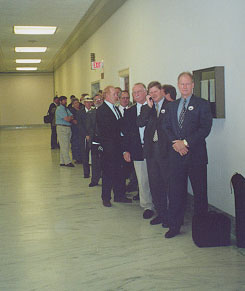
BMWE officers and legislative directors, led by Jim Knight, BMWE
Director of Government Affairs, wait outside the meeting room of the
House Transportation and Infrastructure Committee on July 19. Shortly
after 10:00 a.m. the BMWE delegation watched in silent protest as the
T&I Committee marked up HR 4844 without a hearing.
July, 1877 — First Railroad Strike
From the History of the Brotherhood of Maintenance of Way
Employes, Its Birth and Growth 1887-1955 by D. W. Hertel.
With the close of the Civil War, a new and even more frantic era of
railroad building began. By 1870, the railroad mileage in the United
States had increased to 53,878 and in the ensuing thirty years, almost
140,000 miles of track were laid.
But as the railroads spread their web of rails and crossties
throughout the nation, as business expanded and flourished, the
problems of the worker increased. With growing industrialization came
the inevitable clash between worker and employer.
As workers attempted to band together for their mutual welfare, a
bitter anti-union attitude crystallized among employers. Company
agents were use to discourage union activity. Employers secretly
circulated "whitelists" of persons to be hired and
"blacklists" of those to be rejected.
Eventually the "yellow dog" contract made its appearance
and became a potent weapon against unionism. In signing such a
contract, the employee agreed that so long as he was employed he would
not join or support a labor union. Such a contract was entirely
unilateral, the employer reserving the right to discharge an employee
at will.
It was not unusual for union leaders and organizers to be beaten by
company agents and even forced to leave the community. Public
officials frequently refused to permit unions to hold outdoor meetings
or parades. The distribution of union pamphlets or papers was
prohibited by ordinance. Business and professional people campaigned
against unions, and employers sought the passage of laws to curb their
activities.
By 1873, three railroad Brotherhoods had been organized: the
engineers (1863), the conductors (1868), and the firemen and enginemen
(1873). These organizations had been formed not as collective
bargaining agencies to improve the wages and working conditions of
their constituents, but primarily to furnish insurance benefits to the
families of injured or deceased workers.
So hazardous was their work in those days that many railroad
workers were unable to secure insurance protection from the standard
companies. Railroad owners opposed these fraternal societies, fearful
that they contained the seed of a union movement on the railroads.
The transition of these organizations from purely fraternal and
benevolent Brotherhoods to bona fide labor unions did not begin until
1877, after the first and biggest railroad strike.
This bloody strike resulted from wage cuts ordered by the railroads
during the business depression which began in 1873. The high cost of
the Civil War, excessive railroad building, inflated credit and other
related economic problems had brought on the 1873 panic. Times were
bad and became worse as the panic continued. The ranks of the
unemployed grew larger.
In the early years of the depression, workers on the railroads and
in other industries accepted wage cuts with little protest. In 1877,
the railroads began to feel the severe pinch of reduced income. Their
owners decided that in order to continue to pay dividends and maintain
their credit standing, they must make further wage reductions.
In June and July, 1877, the Pennsylvania, Erie, Michigan Southern,
Lake Shore, New York
Central, and other railroads, put wage cuts of 10 per cent into
effect. Effective July 16, the Baltimore and Ohio ordered a 10 per
cent wage cut in all wages of more than $1.00 a day.
This was the coup de grace that released the pent-up emotions that
had simmered in the minds of the workers during the difficult years of
the panic. They had already accepted several wage reductions, although
many of the railroads had continued to pay substantial dividends to
their stockholders. They could barely support their families on the
meager wages being paid for dangerous and responsible work.
When the company rejected their protest, Baltimore and Ohio firemen
and brakemen at Martinsburg, West Virginia, walked off the job. The
strike spread rapidly and sporadically across the country, from road
to road, from point to point, to Chicago, to St. Louis, and finally to
California.
Several states mustered their militia. Federal troops were called
out to settle a strike for the first time in American history. Riots
and bloodshed followed. The strike was broken, but it is estimated
that in the process more than one hundred men lost their lives and
some five hundred persons, including women and children, had been
wounded. Untold damage had been done to railroad property.
Although railroad workers lost the strike, they had still gained a
victory. For out of the bloody disaster came the realization that the
strike had been lost through lack of unity. A new feeling of
solidarity grew between the Brotherhoods and they emerged from the
phase of pure fraternalism to turn resolutely toward the goals of
collective bargaining.
July, 1887 — BMWE Chartered Under Alabama Laws
July 1, 1939 -- Railroad Unemployment Insurance Act Becomes
Effective in U.S.
Member Profile
King of Swing
by John Prescott
The Summer 2000 issue of Union Pacific Railroad's INFO Magazine
featured BMWE members Jerry Naughton and Jim Pope in the article
"King of Swing," reprinted here with permission of UP.
Naughton, 47, is a 21-year member of the BMWE and is President of
Local Lodge 510 on the Chicago & North Western System Federation.
Pope, also 47, is a 19-year member of the BMWE and is
Secretary-Treasurer of Lodge 510. Both reside in Clinton, Iowa.
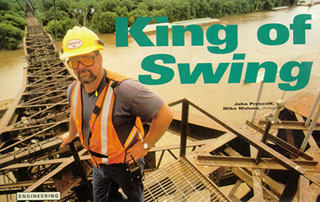
BMWE member Jerry Naughton maintains the largest
double-track swing span on the Mississippi. (Michael Malone,
photographer.)
When America's largest railroad and busiest river cross paths,
something has to give. That "something" is Union Pacific's
swing bridge in Clinton, Iowa. Built in 1909, the structure is the
largest double-track swing span on the Mississippi — 2,200 tons of
iron that moves to let tall river traffic by.
Bridge operators act as traffic cops, balancing the movement of
barges plying their north-south route with trains moving east and west
across the span. The bridge's movable portion is located on the
river's Iowa side and is the longest of the 19 pier-supported spans
crossing a mile of water, island and marsh to the Illinois side.
"It's a great piece of engineering," says Jerry Naughton,
structures foreman. "How many 91-year- old machines do you know
of that are still running efficiently today?"
Naughton has maintained and repaired the bridge for the last 22
years. During that time, he's replaced every gear and shaft, and knows
the meaning of each creak and groan. Every two weeks he greases 365
zirc fittings, feeding lubrication to machinery that's operated
flawlessly since William Howard Taft was President. If Assistant
Foreman Jim Pope helps Naughton, it takes one full day for the pair to
completely service the bridge.
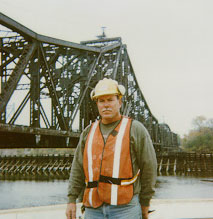
Jim Pope
"They built this thing to last," says Naughton. "It
handles today's intermodal and coal traffic the same as it handled
steam locomotives. Structurally it's sound and mechanically it's fully
operational."
The existing bridge is the fourth to carry trains across the river
Native Americans call "The Father of the Waters." The first
was built in 1860 by the Chicago, Iowa and Nebraska Railroad.
Construction was fast and inexpensive, and it lasted only 22 years.
Numbers two and three, under the Chicago & North Western,
brought improvements but were single track. With rail traffic
increasing, the C&NW built the double-track span for speed and
endurance. It swung open for the first time April 11, 1909, and on
average it now opens and closes every 45 minutes.
Naughton points with pride to a pair of 50 horsepower DC motors
located in the elevated control room at the swing span's center.
"Those are the originals, and they still work perfectly!"
Only one central motor is needed to swing the span. Two additional 50
horsepower motors located at the ends of the swing span lift iron
shoes supporting the ends as well as connecting rails, called Conleys.
According to Naughton, "the originals there were 20 horsepower,
but they burned out too fast. They were replaced with 30 horsepower
motors, and eventually with the current models."
The words "fail-safe" have been the operating mantra of
bridge crews ever since the railroad crossed the Mississippi. If the
bridge can't swing, traffic stops—either on the river or on the
railroad. That's why the swing span is equipped with its own diesel
generator, which automatically kicks in if the electric line from
Clinton fails.
The swing span is staffed 24-hours-a-day, 7-days-a-week during the
Mississippi navigation season, usually running from March to December.
Larry Schultz is one of five bridge operators who monitor track and
river traffic and swing the bridge to keep the two commercial
lifelines moving.
"I was just a little kid when I visited this bridge for the
first time," says Schultz, a veteran of 41 accident-free years at
the railroad. "My aunt knew Harry Peterson, who was the bridge
operator back then. He let me stand on the deck when he swung the
bridge. It looked like the whole world was turning around and I was
standing still."
Schultz and fellow operators Bill Buske, Tom Ebenezer, Jim Jenkins
and Al Simms, spend their shifts monitoring and logging all river and
train traffic.
"Sometimes we get some pretty interesting traffic," says
Schultz, who learns via radio that Australian water skiers are headed
his way. Minutes later, Brenton McGrath and his brother Sean whiz by,
skiing from St. Paul, Minnesota, to the Gulf of Mexico, raising funds
for leukemia and lymphoma research. Their boat is low enough to pass
under the closed rail bridge. However, the span has swung for other
colorful river travelers, including Jacques Cousteau's
"Calypso" and a replica of the Christopher Columbus vessel
"Pinta."
"We swing for three Queens," says Schultz, referring to
regular trips made by passenger river boats "Delta Queen,"
"Mississippi Queen" and "American Queen." Many
large, private craft are tall enough to require the bridge to move, he
said, and "some of us get an eyeful of pretty surprised
sunbathers who look up and see us." However, the river's
heavyweights are barges moving some of the same commodities traveling
over the river on trains.
It takes five minutes and six steps to swing the bridge. Each step
must be verified before electric power becomes available for the next
step. The process begins with signals showing bridge approaches clear
of trains. Then, derails are activated. That allows release of the
rail-locking mechanisms. The Conley connecting rails then are raised
and the iron shoes supporting the swing span withdraw. The span's ends
drop as much as 8 inches. Finally, massive steel key pins on each end
of the swing span retract, making power available to the swing motors.
And, from Schultz's point of view, the world turns again while he
stands still.
Nothing moves, however, unless the swing span's motors, gears and
other parts operate perfectly, and that's where Naughton comes in.
"We do most of our parts replacement and heavy maintenance after
the navigation season. We're always observing gears and shafts for
wear, and planning replacements in advance."
Of course, parts availability is a challenge. "You can't buy
any of this stuff off the shelf," says Naughton. "Most of
the gears and shafts are specially machined at an Illinois foundry. We
keep the worn parts in storage. If a gear breaks, we have a quick fix
that can tide us over until a new gear is available."
Effective lubrication is one of the best insurance policies for
keeping working parts in business. Naughton and Pope use a dark, heavy
substance called molly grease, which is sticky enough to resist
natural elements but slick enough to minimize friction.
Greasing under the bridge is a dirty job made less so by a recent
innovation: paper suits. Employees used to bring a set of work clothes
and wash them at work before eventually discarding them. Pointing to a
wringer-equipped Maytag in a storage room, Naughton says, "That
might be Union Pacific's only company-owned washer."
The Maytag shares its space with dozens of gears, shafts and
special tools. One of the wrenches used by bridge crews is six feet
long. It takes seasoned employees to keep the Mississippi crossing in
operation, including the ironworkers on bridge maintenance and repair
projects.
"The toughest guy I ever knew was ‘The Duke,'" says
Naughton, speaking of the late Don Janss, an iron worker foreman.
"I only worked with him during my first years at the railroad,
and he was a legend long before then."
More than 40 years ago, Janss was knocking out a rivet when a piece
of it flew up and took out his eye. "He pulled a rag from his
pocket, tied it across his blind eye, and finished knocking out the
rivet before he went to the hospital," said Naughton. "The
Duke was one hell of a man."
Today's crews remember the story not only as a tribute to
toughness, but as a safety reminder. Gloves and hearing protection, as
well as improved goggles, hard hats and fall protection, are all in
place to prevent accidents.
Naughton notes,"You still have to be alert all the time when
you're working on this bridge or any bridge. It's hard work, but we
know it's important work." It's also a labor of love, considering
his family's history. "My wife's grandfather actually watched
this bridge being built, back when he was just a boy."
The lad who watched the bridge construction is 99 years old today,
and "The Duke" and countless other railroaders who
maintained and operated the swing span over the decades are gone.
As Larry Schultz's day shift winds down, he moves the bridge for an
excursion boat named "Twilight." As it passes by, the boat's
calliope plays "Love Makes the World Go Round," but the
Clinton bridge crew knows it's hard work and electric motors.
MofW Works With Uncle Sam

"This is a picture of two of our soldiers working in July
along with an Amtrak MofW crew at Westover Air Reserve Base in
Chicopee, Massachusetts," writes Major Martin Piech, U. S. Army
Reserve. "Their assistance was the decisive factor in enabling
the 1205th to operate trains at the airshow in August. I believe
everyone learned from the joint effort. In fact the Amtrak crew headed
up by Damian Garden (in the picture behind the soldier operating the
spiker) has expressed an interest in teaming up with us again
sometime! Our soldiers were/are totally awed by the skill demonstrated
by the Amtrak people. Since the 1205th is rated a high priority
reserve unit, the support and participation of BMWE members
directly/positively impacts our proficiency in supporting vital
interests in our country." The 1205th Transportation Railway
Operating Battalion is based in the greater Hartford, Connecticut area
and is always seeking experienced maintenance of way people to join
their unit as "Citizen Soldiers." For more information see
the September/October issue of the BMWE JOURNAL or contact the unit at
877-519-8533, 860- 632-2117 or 860-635-3335 (select option 3 or ask
for Mr. Heinrich). There is also a unit website — www.1205thtrob.com
— that is loaded with useful information including what they do and
job openings. And look next year for the BMWE JOURNAL feature on the
fascinating history of the 1205th.
July 4 — Independence Day
Have you ever wondered what happened to the 56 men who signed the
Declaration of Independence?
Five signers were captured by the British as traitors and tortured
before they died.
Twelve had their homes ransacked and burned.
Two lost their sons serving in the Revolutionary Army; another had
two sons captured.
Nine of the 56 fought and died from wounds or hardships of the
Revolutionary War.
They signed and they pledged their lives, their fortunes and their
sacred honor.
What kind of men were they?
Twenty-four were lawyers and jurists. Eleven were merchants, nine
were farmers and large plantation owners; men of means, well educated.
But they signed the Declaration of Independence knowing full well
that the penalty would be death if they were captured.
Carter Braxton of Virginia, a wealthy planter and trader, saw his
ships swept from the seas by the British Navy. He sold his home and
properties to pay his debts and died in rags.
Thomas McKeam was so hounded by the British that he was forced to
move his family almost constantly. He served in Congress without pay
and his family was kept in hiding. His possessions were taken from him
and poverty was his reward.
Vandals or soldiers looted the properties of Dillery, Hall, Clymer,
Walton, Gwinnett, Heyward, Rutledge and Middleton.
At the battle of Yorktown, Thomas Nelson Jr. noted that the British
General Cornwallis had taken over the Nelson home for his
headquarters. He quietly urged General George Washinton to open fire.
The home was destroyed and Nelson died bankrupt.
Francis Lewis had his home and properties destroyed. The enemy
jailed his wife and she died within a few months.
John Hart was driven from his wife's bedside as she was dying.
Their 13 children fled for their lives. His fields and his grist mill
were laid to waste. For more than a year he lived in forests and
caves, returning home to find his wife dead and his children vanished.
A few weeks later he died from exhaustion and a broken heart.
Norris and Livingston suffered similar fates.
Such were the stories and sacrifices of the American Revolution.
These were not wild-eyed, rabble-rousing ruffians. They were
soft-spoken men of means and education. They had security but they
valued liberty more.
Standing tall, straight and unwavering, they pledged: "For the
support of this declaration, with firm reliance on the protection of
the divine providence, we mutually pledge to each other, our lives,
our fortunes and our sacred honor."
They gave you and me a free and independent America. The history
books never told you a lot about what happened in the Revolutionary
War. We didn't fight just the British. We were British subjects at
that time and we fought our own government!
Some of us take these liberties so much for granted, but we
shouldn't.
So, whenever you're enjoying your 4th of July holiday, take a
minute and silently thank these patriots. It's not much to ask for the
price they paid.
Remember that the cost of freedom is never free!
Author Unknown. Submitted by BMWE member Jeffrey Bainter, Muncie,
Indiana.
Member Profile
Member's Heroism
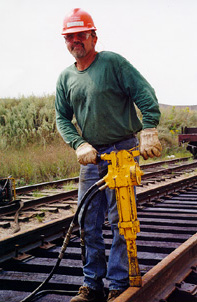
Dale Johnson of Rockland, Wis., a machine
operator for Canadian Pacific Railway, uses a hydraulic spike driver
as a crew replaces a grade crossing in Eagan, Minn. Johnson was
commended recently for helping get a family of four on bicycles out of
the path of an Amtrak train on July 20 in Reeseville, Wis.
Dale Johnson's work week replacing the only public grade-crossing
in the tiny Wisconsin town of Reeseville was over. Or so he thought
until he saw a family of four on bicycles crossing Canadian Pacific
Railway's tracks where Amtrak's Empire Builder was soon due.
Johnson, a machine operator for CPR, and CPR laborer Steve Cox had
mistakenly driven down a dead-end street at about 6 p.m. July 20 to
leave the quiet town of 700 people 10 miles northwest of Watertown.
Turning around, they had to drive back by CPR's main line and the
crossing.
As they approached, they saw a man on a bike cross and wait by the
westbound tracks. A woman with a toddler in tow was stopped on the
eastbound tracks. In between them, a girl of about 6 was straddling
her bike while trying to pick up something she had dropped on the
westbound tracks.
"Dale mentioned that Amtrak No. 7 was supposed to be in the
area. As soon as the words came out of his mouth, the westbound train
whistled from around a bend, and the lights and bells on the crossing
signals started up," Cox said.
The train, which travels up to 65 mph in the area, was a quarter of
a mile away. Knowing it would reach the crossing in about 15 seconds,
they watched in horror as the family didn't react. But Johnson sure
did.
"He was out there in a heartbeat," said Cox, who watched
in amazement as Johnson left the driver's seat of their truck and ran
toward the girl.
""By now, the gates were down, and she was in the middle
of the track crying," Cox said. Johnson said he probably scared
the girl by running at her and shouting at the man.
"I was yelling at him to come get his daughter. ‘Amtrak is
coming,'" Johnson said. "I think he just froze."
Johnson was pushing the girl off the track when the man came to
help. But Johnson's work still wasn't done.
"Right then, when the girl was in the clear, the mother
panicked and then she started across," Cox said.
"He grabbed her handlebars and pointed at her to get back. She
backed up a few steps so she was barely in the clear," Cox said.
Without waiting around for thanks or to introduce himself, Johnson
returned to the truck to head home to Rockland, which is 18 miles east
of LaCrosse. He didn't get the family's name, which remains unknown.
"I said, ‘My heart is still pounding a mile a minute.' I
said, ‘Did I overreact?'" Johnson asked.
"I don't think so," Cox replied.
Cox was so impressed by his co-worker's actions that he wrote a
company report about it for discussion at their crew's weekly safety
briefing.
"There is no doubt in my mind that without Dale Johnson's
awareness of the presence of the train, the quickness of his reaction
and the wherewithal to handle the situation, something tragic probably
would have happened in Reeseville that day," Cox wrote.
Rick Wedel, CPR's Chicago Service Area manager for engineering
services, was impressed.
"It was very quick thinking. He certainly is to be commended
for it," Wedel said.
Donald McCall, CPR manager of track programs and equipment in
Minneapolis, wrote Johnson a thank-you note and enclosed a watch as a
token of the railway's appreciation.
"From discussing the incident with several witnesses, it is
very clear that had it not been for you, a very tragic accident would
have occurred," McCall wrote.
Town librarian Carla Eauslin said she thought the family, whose
name she didn't know, was heading home from the library that night and
that the little girl was trying to pick up library materials she had
dropped on the track. She expressed gratitude for Johnson's actions on
their behalf.
"If he was here right now, I would say thank you for saving
these people," she said.
Canadian Pacific Railway News Release, September 14, 2000,
reprinted by permission, Laura Baenen, CPR Communications
Representative. Dale Johnson, 47, is a 29-year member of BMWE, Local
Lodge 1965, Chicago, Milwaukee, St. Paul & Pacific System
Federation..
July 20-21 — AFL-CIO Transportation Trades Department Convention
TTD: A Bold Voice, A Decade of
Action
For the BMWE, as reported in the last issue of the BMWE JOURNAL,
the most significant policy resolution passed by the delegates to the
TTD's 10th Anniversary Convention was the demand for the National
Mediation Board to release the BMWE from mediation immediately. This
resolution was an extension of Resolution No. 2 — Strengthening a
Worker's Voice on the Job.
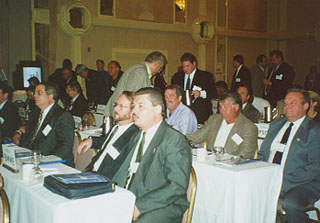
BMWE Delegation to TTD 10th Anniversary
Convention.
Nine other significant resolutions were also passed by the
delegates to the TTD's third regular convention — 1) Worker
Protections and Labor Standards in the New Economy; 3) Transportation
Workers and Globalization; 4) Foreign Postal Operations Threaten U.S.
Transportation Jobs; 6) Financing America's Multi-Modal Transportation
Needs; 7) Speaking Out Against Senseless Energy and Environmental
Policies; 8) The Destructive Legacy of Privatization, Competitive
Bidding and Contracting Out; 9) Technology and Worker Rights on a
Collision Course; 10) Crusading for a Safer Transportation System.
Resolution No. 5 — Building a Movement of Legislative Activists
— is vitally important to the BMWE as well as to all of
transportation labor and not just because BMWE President Fleming is a
member of the TTD Legislative Activist Committee which prepared the
resolution.
Most BMWE members know how strongly the federal government and its
agencies impact their working lives but the fact is that
transportation workers in general are among the most heavily
regulated. There is as much at stake for them in the political and
legislative arena as for any other segment of the work force.
Whether it be safety issues and enforcement or complex oversight
rules including alcohol and drug testing mandates or federal funding
decisions relating to highways, mass transit, Amtrak, airports, air
traffic control, ports and more, the work of Washington lawmakers
matters immensely to transportation workers.
That is why the TTD Legislative Activist Committee proposed
Resolution No. 5 which was approved unanimously at the convention. The
key component of the plan calls for strengthening transportation
labor's grassroots presence by enlisting a permanent force of workers
in the field who will speak out on important legislative and
regulatory issues, both during and between election cycles.
In the few short months following the convention, hundreds of
activists were identified by TTD affiliates and participated in the
initial effort which focused on educating members on the issues at
stake in the fall election, including key transportation issues such
as NAFTA truck and bus safety, right-to-work laws, Amtrak
privatization, transit privatization, U.S. port privatization and
Frank Lorenzo, a prominent George Bush booster and former Eastern Air
Lines boss and union buster who destroyed 44,000 airline jobs along
with Eastern.
"The labor movement's 2000 mobilization is not simply about
influencing the outcome of the fall elections," the resolution
noted. "It is about mobilizing working families to counter the
flood of unregulated corporate money being peddled at the federal,
state and local level. And it is about building a permanent network of
legislative activists who are willing to combat the unrelenting
campaigns of those out to roll back workers' rights and safety
protections and dismantle federal programs."
The speakers at the convention also reflected the importance of the
government to transportation labor. They included Senate Minority
Leader Tom Daschle (D-SD), Rep. Don Young (R-AK), House Minority
Leader Richard Gephardt (D-MO), Secretary of Transportation Rodney
Slater, Rep. James Oberstar (D-MN) and Vice President Al Gore.
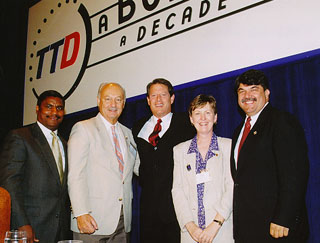
Following his moving address to the TTD
Convention, Vice President Al Gore is shown with Secretary of
Transportation Rodney Slater, left, TTD President Sonny Hall, TTD
Secretary-Treasurer Pat Friend and AFL-CIO Secretary-Treasurer Rich
Trumka.
In a nationally-televised address that brought a rousing conclusion
to the Convention, Gore told the packed audience that a
"fundamental divide" existed in his race for the presidency
against
George W. Bush.
"In her famous union song, Florence Reese summed up this
entire election (when) she asked very simply and powerfully, which
side are you on?" Gore emotionally declared. "That's what
this election is all about. I'm on the side of the people, he's on the
side of the powerful. I'm on the side of working families. He's on the
side of the powerful special interests."
While conceding that his opponent enjoys the support of numerous
wealthy corporate donors — HMOs, oil, transportation, insurance and
pharmaceutical companies to name a few — Gore brought the delegates
to their feet when he said "I'll take transportation workers any
day of the week."
In addition to President Fleming, the BMWE delegation to the
convention included Vice Presidents Ken Deptuck, Rich Lau, Ernie
Torske and Henry Wise, Executive Board Member Jed Dodd, Assistant
General Counsel Don Griffin and Director of Strategic Coordination and
Research Joel Myron.
July 31, 1946 — Railroad Unemployment Insurance Act
Amended to Provide Sickness Benefits
AUGUST
Member Profile
Road/Railer Drivers Really Get Around
Communications Representative Laura Baenen of the Canadian Pacific
Railway sent the following CP New Release and photographs featuring
BMWE members with permission to reprint in the BMWE Journal. Harlon R.
Hanson, 55, is a 22-year member of the BMWE from Local Lodge 1552, Soo
Line System Division. Also from the Soo Line System Division are David
J. Picotte, 39, a nine-year member and President of Lodge 1488 and
Donald J. Noble, 42, a 23- year member from Lodge 1662. Bill Konetzke,
43, is a 21-year member and is Assistant General Chairman on the
Chicago, Milwaukee, St. Paul & Pacific System Federation as well
as Secretary-Treasurer of Lodge 1841. Also from the CMStP&P is
David Johnson, 44, a 25-year member from Lodge 99.
Harlan Hanson drove down a highway one muggy August morning from
the western Minnesota prairie to a Minneapolis suburb where he spent
less than an hour waiting for a road crew to unfold a loading ramp and
drive rail and tie gang equipment up onto flatcars and secure them.
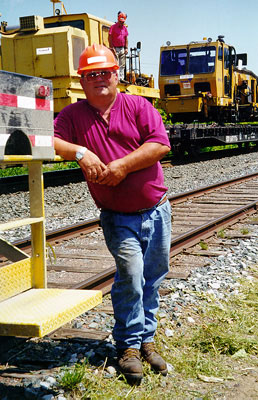
BMWE member Harlan Hanson of Rosholt, South
Dakota waits at the back of his Brandt Road/Rail Power Unit in
suburban Minneapolis while crews finish loading rail and tie gang
equipment in August onto flatcars so he can drive them down Canadian
Pacific Railway track to the next day's work site.
With the help of co-worker Dave Picotte of Alexandria, Minn.,
Hanson then coupled his 47,000- pound Brandt Road/Rail Power Unit to
the cars. Instead of returning to the highway, he pulled the cars west
down Canadian Pacific Railway's main line at 25 mph to deliver the
equipment for the next day's job.
That's right. He drove down the tracks in what looks like a
semi-trailer truck.
The process used to take all day before the advent of the
road/railers, as the hybrid highway tractor unit is affectionately
called at CPR, which owns 11 of the 40 units sold in the United States
and Canada. It used to take a crane to load and unload equipment and a
work train or a car mover, which could pull no more than three cars
down the track no faster than 12 mph.
Now, Hanson said, "It only takes about three minutes to put it
from the road to the rail or from the rail to the road. It's so
versatile."
Canadian Pacific was among the first Class I railways to employ
road/railers, said Don McCall, manager of track programs and track
equipment in Minneapolis.
"It's a lot more efficient than the conventional way of moving
cars and handling material," McCall said. "The road/railer
is strictly used for handling company material cars and material for
track work. It's not used at all for revenue."
Hanson, who lives in Rosholt, S.D. and is based out of nearby
Hankinson, N.D., is an old hand at operating the road/railer. It is
modified with retractable wheel sets and rail equipment so it can run
on highways and standard-gauge railroad tracks.
For three years now, Hanson has been averaging between 30,000 and
40,000 miles a year, working from Portal, ND to Minneapolis-St. Paul
and from Glenwood to Noyes, Minn. in the $400,000 vehicle made by
Brandt Road Rail Corp. of Regina, Saskatchewan.
The lure of the open road still appeals to Hanson.
"You don't know where you're at one day to the next. It makes
the days go faster, and it's a lot cleaner work," said Hanson,
who used to operate a ballast regulator.
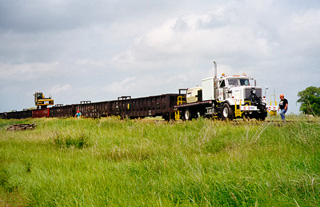
Hanson stands in front of his Brandt
Road/Rail Power Unit as he and fellow BMWE member Donald Noble of
South Range, Wisconsin finish a day's work unloading ties near
Anamoose, North Dakota.
Hanson likes traveling so much that he often spends vacations
riding with his wife on his Victory motorcycle. He acknowledges that
he also likes getting away from the two cell phones and the radio to
the dispatcher that he carries in the road/railer.
The road/railer does much more than pull rail and tie gang
equipment. Earlier this summer, Hanson was called to the scene of a
washout near Detroit Lakes, Minn. to help replace track. The
road/railer more often is used to deposit new ties and pick up old
ones and move welded rail. A track backhoe crawls inside of the cars
pulled by Hanson's road/railer, picking up ties in the cars and
swinging out and depositing them on the ground. East of the Twin
Cities, a Jimbo tie unloader crawls along the tops of the cars to
unload ties. The road/railer also is used for dumping rock and riprap.
In January, Bill Konetzke of Oconomowoc, Wis. began operating CPR's
other road/railer in the Midwest. His territory extends east from
Minneapolis to Louisville, Ky. He still marvels at the miles he can
cover in one day and the unit's payload.
"I could be working in Milwaukee and the next day be up in
Minneapolis and be ready to go there. It's so mobile. Using the
interstate system, we could be two states away the following day and
ready to go," said Konetzke, who averages about 2,000 to 3,000
miles a month.
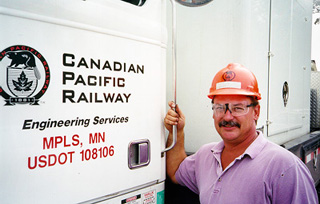
BMWE member Bill Konetzke of Oconomowoc,
Wisconsin stands with his Brandt Road/Rail Power Unit. He operates the
hybrid highway tractor unit on Canadian Pacific Railway track from
Minneapolis to Louisville, Kentucky.
Konetzke typically hauls six to 10 cars a day with the road/railer.
But he'll never forget the day he hauled 15 rock cars weighing 100
tons apiece.
"That was the biggest payload I've hauled so far. That's an
impressive amount for this truck. I operated locomotive cranes in the
past, and we maybe had two or three rock cars at a time," he
said.
Road/railer operators have to be qualified crane operators,
qualified to operate air brakes and hold a Class A commercial driver's
license.
"Road/railer operators have got one heck of a lot of
responsibility. You're switching cars, and you're required to follow
the same rules as the trains," McCall said.
The road/railers have a horn on the steering wheel like automobiles
have, an air horn like trucks and a train air horn. The road/railer
has a reversing transmission so it can travel backward just as fast as
forward. It's equipped with a nine-speed standard transmission.
Although it's not automatic, it doesn't have a clutch. A computer does
the shifting. It's also equipped with air brakes for the rolling
stock.
Hanson and Konetzke each work with a ground man who take turns
operating the truck.
Hanson's second operator is Dave Picotte of Alexandria. Konetzke
got a new second in August. He is David Johnson of Hartford, Wis.
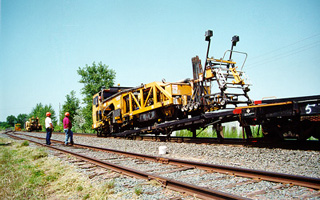
BMWE member Dave Picotte, left, of
Alexandria, Minnesota and Hanson watch as a production tamper is
driven up a ramp onto a flatcar in August in suburban Minneapolis.
Picotte then attached the road railer to the flatcars loaded with
other rail and tie gang equipment so Hanson could drive them down
Canadian Pacific's tracks to the next day's work site.
"He'll tie in air on the cars, throw switches and protect my
rear movements. He's the flagman. They're my eyeballs on the back
end," Konetzke said.
After 20 years on the track as a locomotive crane operator,
Konetzke said he adjusted easily to his new job.
"It's nice being on new equipment. And it sure is nice being
appreciated by my supervisors. They're a good bunch to be working
for," he said.
CPR provides rail and intermodal freight transportation services
coast to coast over a 14,440-mile network extending from Montreal to
Vancouver and throughout the U.S. Midwest and Northeast. Commercial
alliances with other carriers extend CPR's market reach beyond its own
network. Serving ports on the coasts of Canada and U.S., and the Port
of Vancouver, CPR links North America with European and Pacific Rim
markets, moving large volumes of import and export goods across the
continent. It is also a leading carrier in the intermodal industry
with 24 terminals across Canada and northern U.S.
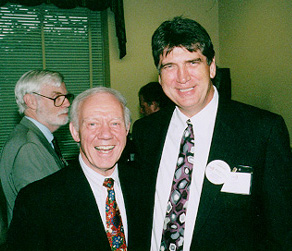
BMWE President Mac A. Fleming, right, with friend
of labor James Oberstar (D-MN) at a reception in August. Oberstar, the
Ranking Minority Member on the House Transportation &
Infrastructure Committee would have become chairman next session if
the Democrats had been able to take control of the House from the
Republicans in the November elections.
August 7 — Sesame Street Section Houses Revisited
In the November/December 1999 BMWE JOURNAL I wrote a brief article
about a visit I had made to a Burlington Northern Santa Fe section
house which I called "Sesame Street Section Houses" because
of all the colors — bright red, orange, yellow, blue, green —
various items therein were painted. These colors were used at the
direction of the Slip, Trip and Fall Committee and in the article I
questioned the Committee's focus on safety and the relevance of the
colors.
Early in January I received a phone call from Jeff Metcalf, a track
welder and 23-year member of the BMWE in Local Lodge 2402, who kindly
admonished me for "poking fun" at the ST&F Committee and
quickly set me straight on the ST&F Committee's emphasis on
safety.
Metcalf, 42, from Ft. Madison, Iowa, married and the father of
three daughters, lost an eye on the job in 1977 when he was struck in
a head on collision. Since then he has been very safety conscious and
believes "I am my brother's keeper." That's why he was more
than willing to serve on the ST&F Committee.
The ST&F Committee was established on the former Santa Fe
Railroad in 1994 and earlier this year was joined with the BN
Materials Handling Safety Team because the teams were so often
overlapping each other. The joined entity is called WEST for Work
Environment Safety Team. WEST's primary goal is "a work
environment, including the resources and tools, that is safe and
accident free where all known hazards will be eliminated or safe
guarded."
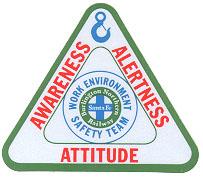
WEST is comprised of 30 plus members composed of one-third
supervisors and two-thirds craft employees, selected evenly throughout
all department areas. Members are approved by their respective
organizations. Team members serve for a term of at least three years
and each year 1/3 of the members rotate off the team and are replaced
by new members in the craft areas they represent. The first rotation
of the newly established WEST will be in 2003.
WEST members commit to at least seven days a month for the
three-year period. Their responsibilities include: ensuring that safe
production is job #1 — if it isn't safe, don't do it; attending
regularly scheduled assessments and meetings; be willing to take on
special projects for the team concerning related safety issues; and
keep up to date on the Work Environment Process Assessment Form.
In addition to Metcalf, there are currently five other
BMWE-appointed members on WEST. Joining him from the Atchison, Topeka
& Santa Fe Federation is Ray Chavez; from the Burlington System
Division are Pete Carlberg (Lodge 1074) and Terry Eck (Lodge 1108);
and from the Burlington Northern System Federation are Edward Obregon
(Secretary-Treasurer of Lodge 1280) and Bruce J. Sharbono (Lodge 295).
Sharbono is also Co-Vice Chairman of WEST.
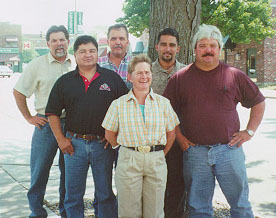
The purpose of BNSF WEST is to provide a process to recommend
actions for addressing and assessing actions taken to address system
wide safety concerns.
However, as noted in its charter, WEST will not participate in
behavioral assessments, craft/management joint auditing, work
practices assessments, or any other issue that would result in any
WEST craft member getting in a conflicting position with their
respective unions and/or current labor agreements. The only exception
would be upon approval of all union leadership and consensus of WEST.
On August 7 I was welcomed to WEST's Illinois Division Debriefing
in Galesburg, Illinois. Beginning with a safety briefing, the meeting
included presentations on WEST history and past accomplishments and
from eight sub-teams on the results, findings and possible solutions
to the Illinois Division assessment. The highlight of the briefing was
slides depicting winners of the "Award of Excellence" (the
"Good Housekeeping Award" under ST&F).
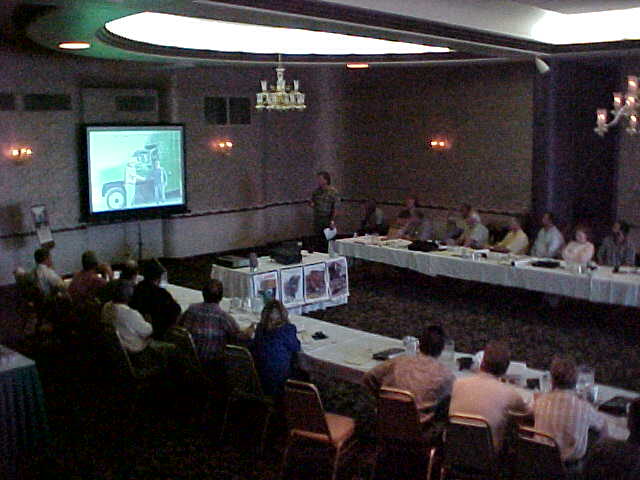
BNSF August 7 WEST
debriefing in Galesburg, Illinois.
A score of 90% or higher is the standard for the WEST Award of
Excellence for facilities and vehicles. Samples of the numerous items
scored on an assessment are: are all areas clean, organized and in a
sanitary condition; is there adequate lighting and protective covers
and shields in place; are all wires and cords properly secured in
place; are hazards marked and/or illuminated for visibility; are
flammable cabinets provided and used properly; is the proper
collection and disposal of used material being provided; are there
unobstructed pathways.
And that brings us to the relevance of the colors. After the
following was explained to me, I understood the importance of the
color code for marking physical hazards.
Yellow - The basic color for designating caution and for marking
physical hazards such as striking against, stumbling, falling,
tripping, and "caught in between."
Green - The basic color for designating safety and the location of
first aid equipment(other than fire fighting equipment).
Red - The basic color for fire protection equipment &
apparatus; danger such as safety cans or other portable containers of
flammable liquids having a flash point at or below 80 F.; stop such as
buttons or electrical switches used for emergency stopping of
machinery.
Orange - The basic color for designating dangerous parts of
machines or energized equipment which may cut, crush, shock, or
otherwise injure and to emphasize such hazards when enclosure doors
are open or when gear, belt, or other guards around moving equipment
are opened or removed, exposing unguarded hazards.
Black/White, Black/Yellow or Yellow are the basic colors for the
designation of traffic and housekeeping markings.
---S. L. Creswell
August 14 — America 2000 - The Democratic Convention
A small delegation led by BMWE President Mac A. Fleming attended
the Democratic Convention held in Los Angeles, California this year
beginning on August 14. A comparison of the 2000 Democratic National
Platform: Prosperity, Progress and Peace to the 1996 Platform was made
by the AFL-CIO and is reprinted below.
Overall, the 2000 platform has a much more positive tone and more
working family-friendly policies than the 1996 Platform, reflecting
the more progressive policies of Vice President Al Gore.
Organizing. The 2000 platform acknowledges the critical role played
by unions in improving living standards for working families and
states that "workers' freedom to choose a voice at work is a
fundamental American right that must never be threatened, never be
obstructed, never be taken away." It also calls for specific
labor law reforms to protect this right. While the 1996 platform
enumerated some important union issues (e.g., support for measures to
ban the use of economic striker replacement workers), it did not
include a strongly worded endorsement of the right to organize.
Trade. The 2000 platform is considerably more forceful in its call
for the incorporation of labor, human rights and environmental
standards into all trade agreements. Unlike the 1996 platform, the
2000 platform mentions the importance of protecting against import
surges that threaten our workers and communities. The 2000 platform
also includes a discussion of international institutions, with a call
for those institutions to consider labor, human rights and
environmental standards in their activities, and opposes opening the
border to cross-border trucking and bus operations until appropriate
safety and worker protection standards are in place.
Immigration. The 2000 platform reflects a significant improvement
in tone and substance over the 1996 platform. The 2000 platform
recognizes the failure of current immigration laws and enforcement
policies and the need for stiff penalties for employers that exploit
workers' immigration status. It also supports linking H-1B visa
increases to genuine labor shortages, strong worker protections and
increases in fees to support worker training, rejects expansion of
exploitative H-2A guest worker programs, and supports adjusting the
status of immigrants with deep roots in this country. The 1996
document, by contrast, emphasized Democrats' efforts to stop illegal
immigration and did not recognize the failure of current policies.
Education. The 2000 platform reflects a greater focus on education
issues than in 1996, though it generally hits on the same core themes
(education is critical to America's future; strengthen public schools
by expanding teacher training and imposing new student achievement
standards; don't divert tax dollars away from public to private
schools; safe, healthy students and schools; bring technology to the
classroom). This year's platform does more to address teacher training
issues, rejects block grants without accountability and includes a
call for smaller classes and ambitious school modernization.
Health Care. The 2000 platform more explicitly promotes increasing
health care coverage and endorses specific policies designed to
address that issue. It also calls for expanding Medicare to include a
prescription drug benefit and enacting new patient protections.
Social Security. Unlike the 1996 platform, the 2000 platform
squarely rejects privatization and raising the retirement age and has
a greater focus on protecting and strengthening Social Security. The
platform contains a new call for providing low- and middle-income
workers with additional retirement resources through supplemental
retirement savings accounts funded, in part, with progressive
government matching contributions.
Low Wage Workers. The 2000 platform includes important new language
recognizing the value of work done by those who labor in jobs that pay
low wages and may not require significant education or skills. While
the 1996 platform addresses issues important to low wage workers, the
language is not nearly as strong.
August 20 — For The Children
by April Mang
How the Midwest Was Won
They came from as far as the California coast, carrying their gym
bags, stretching on the sidelines, wearing that "I'm not here for
funny business" look on their faces. They were here to break a
record—to get their names published as the official fastest in the
world. This was not the Olympics. The sport is not that well known
yet. This was the "For The Children Handcar Races" and they
were here to win.
It was Sunday, August 20, 2000. We had tested the timer the weekend
before at our McHenry, Illinois location in Petersen Park. We did not
anticipate the 60 teams that showed up to register, but we were ready!
The track was 984 feet, the standard distance for handcar racing, as
set forth in the Guinness Book of World Records. The current record
was held in England and we wanted this to be the day it was beaten.
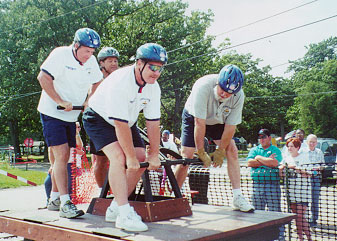
In the past, this race had been held only to raise money for
children's hospitals. Somewhere along the line we all got the
competitive spirit. The teams were here to support the children, but
more than that, they wanted to win! Here is how it worked. A five
person team, made of four pumpers and a pusher, would race the 300
meters in their category. The two fastest teams from each category
raced again in the finals. The times of the two races were combined to
reach an average for overall time.
The results? Well they came in many forms! As for the size of the
event, I have never heard of having more than 40-some teams in an
event. Our 60 teams blew that out of the water! With around 5,000
people in attendance throughout the day, it took nine hours to finish
the heats.
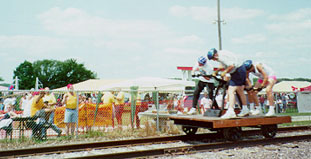
"The Dark Horse Express," a team from northern
California, had the fastest single run of the day at 38.54 seconds for
the 300 meter haul; Union Pacific Railroad's own Chicago-based
"Steel Horsemen" took the overall top combined time for the
third year in a row, racing an average time of 38.63 in all races. So
the world record eluded us—for now. We have been told it was beaten
at a hometown race in Boulder, Nevada earlier this year, so we have
more to shoot for in the future!
Five women's teams also raced—the fastest time coming less than
four seconds away from the men. WATCH OUT, we're on your tail! Next
year we will close the gap.
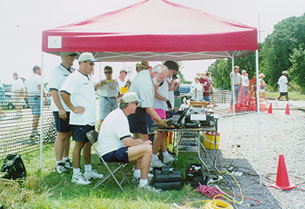
The $29,000 raised brought donations to Children's Hospitals to
over $107,000 since 1995. That's not all! Aside from the purchase of
equipment, two new events were proposed to help the community.
Colorado will host a race to benefit children, and there will be a
race in northern California to benefit their railroad museum. We are
proud of this growth and hope it will continue!
Other ways that the event was a success: Over 800 attendees
participated in the drunk driving simulation hosted by the Alliance
Against Intoxicated Motorists. While the blood drive was canceled due
to an equipment failure, demonstrations were done by DARE, Operation
Lifesaver, and many others. The vendor and safety fair tents were full
for the afternoon, and the barbeque sold out by the end of the lunch
hour.
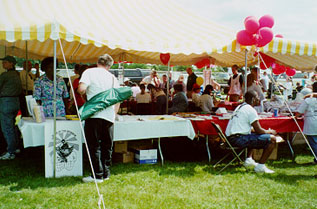
Next year's For The Children races will again be held in August.
Information is available on our website, www.handcar.com, or if you
prefer to talk to a person, call coordinator Gary Mang at (847)
623-6155. We are always looking for sponsors and participants! And
event hats and shirts are still available.
Handcar Racing
Despite the fact that the handcar is heavy and hard to come by,
handcar racing is increasing in popularity, both in and outside of
railroad circles. An official handcar race has been dated back to
1949, at the Chicago Rail Fair, where a five man team from the Penn
Central Railroad won the event.
Over the last 10 years handcar racing has started to make a come
back. There is a growing group of BMWE members who would like to keep
this tradition and history alive and well. They have gotten their
friends and family members to become regular participants! This
competition is a grand discovery for new race enthusiasts who thought
the local "do" was the only competition! There are over 15
races a year. You can locate the nearest race near you at
www.handcar.com.
A few traveling Union Pacific Railroad employees have done quite
well at these events during the past year! Gary and I have been among
those who attend as many races as possible. It's very exciting as well
as addicting! Gary's team won the silver medal in May when he traveled
to Folsom, California for their Handcar Derby.
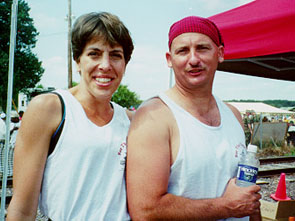
April & Gary Mang
My first "away" race was the "World Championship
Handcar Race" in Port Moody, Canada last July. Maybe it was just
luck, or maybe it was all the basement weight lifting, or the exercise
chasing our twins around, but whatever I did, we came home heavy;
loaded down with medals! As a mixed team that consisted of two women
and two men pumpers, we won gold. This race was the most gratifying to
me, since Gary and I were racing as a couple.
Gary also won the gold medal with his men's team, and I won silver
in the ladies division. Chicago's Steel Horsemen, another Union
Pacific Railroad team, won fastest railroad team in Canada. This was
the first time for an American railroad team to win this division. For
the last 20 years the railroad division was dominated by Canadian
Pacific Railroad BMWE racers. The locals vowed to come to Chicago for
vindication at the 2001 FTC handcar Races.
As we were exhausted, and on a winning high, we planned our next
race. Our designation was Boone, Iowa for their Pufferbilly Railroad
Days. At this competition we were again successful, taking home first
place plaques in the men's and coed divisions.
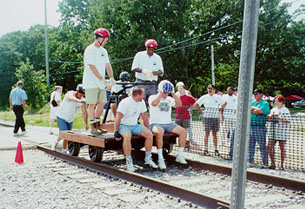
In September we went to Nevada. The competition was tough. Gary and
I were on a coed team that did not place. On my all women's team we
took a gold medal, and Gary's men's team from Chicago took silver
medals in the heavy weight division.
My first year of being introduced to competing in railroad handcar
racing was a good year. I am planning now to compete as much as
possible in the years to come. I believe that anyone can do this if I
can. It takes some amount of cardio, but team synchronization is the
most important thing. Realize that anyone can race. We have
competitors of all ages. At the Nevada races in September there was a
team of women who had to be in their seventies! This was a great sight
to see. But what else can I expect from this family event.
Handcar racing is growing and hopefully in the near future it will
be an Olympic Sport. As of right now there are five countries that
host handcar races. It takes seven countries to qualify to be under
consideration for the Olympics. I hope that this article encourages
you to be a part of this great railroad tradition and get involved
with the local handcar race near you.
Next year I would like to compete in either Alaska or Australia,
airline miles permitting! Maybe I'll see you at the Races.
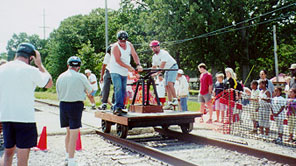
SEPTEMBER
On September 26 President Fleming wrote a letter to the National
Mediation Board requesting a meeting with the full NMB for the purpose
of answering questions by Board members as to why a proffer of
arbitration should not be immediately given. Fleming noted that it had
been more then two months since the BMWE had met with the NMB and
presented a case that further negotiations between the NCCC and BMWE
would be fruitless and requested a proffer of arbitration. At that
meeting, the BMWE raised its strong concern that protracting
deadlocked negotiations only assists the railroads by placing unions
in the untenable position of having to cut a deal which provides less
for their members if they have any hope of an expeditious resolution
of a bargaining round.
After over two years of intense struggle, the BMWE's battle for an
earlier retirement was virtually lost on September 7 when the House of
Representatives passed HR 4844 by a vote of 391 to 25 with 19 not
voting. On September 8, as over 50 BMWE officers and state legislative
directors prepared to gather in Washington, DC to make a last ditch
effort to try to stop the bill from passing the Senate, the BMWE and
BLE were contacted by Robert Allen on behalf of the carriers. Allen
made it clear that if the BMWE and BLE did not support the legislation
in the Senate, the railroads would not provide the health insurance
included in the deal made a year ago with the other unions. Health
insurance is not part of the legislation. Joel Myron, Director of
Strategic Coordination and Research, advised Allen that while the BMWE
simply could not support the legislation, the BMWE would withdraw its
opposition in return for receiving the health insurance. On September
12, BMWE withdrew its opposition to the legislation after receiving a
letter from Allen as the carriers' representative, guaranteeing the
health insurance to BMWE members if the bill becomes law.
September 1, 1949 — Forty-Hour Week Established in
the U.S.
September 4 — Labor Day
Joining Vice President Al Gore in Pittsburgh, AFL-CIO President
John Sweeney celebrated Labor Day with 10,000 union members and their
families. "We will win and Al Gore will win because we share the
belief that no worker should lack the kind of pay and benefits it
takes to feed and house and love a family," Sweeney said at a
Point State Park rally. Secretary-Treasurer Richard Trumka and
Executive Vice President Linda Chavez-Thompson headlined events in
Portland, Ore., and Syracuse, N.Y., respectively. UAW President
Stephen Yokich joined Gore running mate Sen. Joseph Lieberman (D-CT)
at a Detroit rally, while AFSCME President Gerald McEntee was in
Chicago with Tipper Gore and Hadassah Lieberman. Electing leaders who
will support working families by advocating the right to a voice on
the job, health care, education, Social Security and Medicare was on
the top of the Labor Day agenda. In Los Angeles, activists enjoyed the
annual parade and then fanned out into the neighborhood, going door to
door to whip up support for the local congressional candidate. The
Conconino and Navajo Counties Central Labor Body in Arizona hosted its
first Labor Day parade. In Charlotte, N.C., a Labor Day parade was
coupled with the release of a report by the Common Sense Foundation on
the state of working families in North Carolina, advocating the repeal
of anti-union laws to help workers benefit from the economic boom.
Meanwhile, at more than 650 religious services around the country,
union advocates discussed turning faith into action as part of the
fourth annual Labor in the Pulpits program, a joint project of the
AFL-CIO and the National Interfaith Committee for Worker Justice. And
thousands celebrated a "virtual" Labor Day by pointing their
Web browsers to workingfamilies.com for the AFL-CIO's first-ever
Online Labor Day Festival.
First Online Labor Day Festival
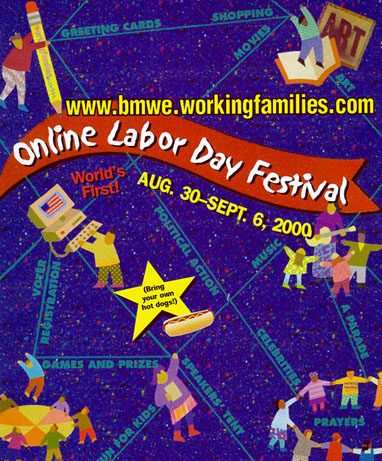
A typical Labor Day — a parade, bands, speeches, games. But this
year there was no threat of sunburn and it couldn't be rained out. But
you did have to bring your own hot dog.
In addition to Labor Day festivities in hometowns across America,
this year union members also celebrated in cyberspace — with the
world's first nationwide Online Labor Day Festival.
From noon August 30 through September 6 the one-week celebration of
America's workers was housed on the first Internet community created
especially for working men and women — www.workingfamilies.com. The
BMWE is one of the 23 unions representing more than ten million
members who have joined the new Internet community since it opened its
doors in February.
The virtual festival served as a two-way informational highway,
giving the general public a chance to learn about how unions improve
people's lives while also helping to make the web work for working
people.
Festival-goers found an online parade, a voter registration booth,
a mailbox to elected leaders, audio greetings from union leaders and
superstar union members, arcade games such as "Smash Corporate
Greed," a labor and faith gathering, an online bazaar with
union-made goods, a music tent and much more.
September 16 — UTU Members Strike Los Angeles MTA
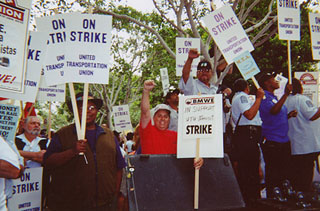
At 12:01 a.m. Saturday, September 16, some 4,400 members of the
United Transportation Union walked out on the Metropolitan
Transportation Authority in Los Angeles, California. The MTA operates
the nation's second-largest bus system with about 2,000 buses on 200
routes as well as 59 miles of subway and light rail lines.
Contracts between the MTA and UTU, the Amalgamated Transit Union
and the Transportation Communications Union expired June 30. Talks
broke off Friday night, September 15, two hours before the midnight
deadline.
An MTA proposal to cut overtime costs by 15% was one of the
critical issues. The MTA wanted at least 400 of its 4,400 drivers to
accept new four-day workweeks in which they would be on duty at least
12 hours, but be paid for only 10 hours a day. The other two hours
would be preparation or break time. No overtime would be paid until
after 12 hours.
While the MTA offered a wage increase of 8.1% over three years,
union officials said the 15% reduction in overtime could cost
operators far more than they would make from the wage boost.
The highest-paid operators make $20.72 an hour or about $43,000 a
year. Many drivers, however, earn $10 to $11 an hour.
On the first day of the strike, pickets were successful in
preventing the MTA from using private contractors to operate emergency
bus service because drivers for the private companies, represented by
the Teamsters union, refused to cross the UTU picket lines.
Although 450,000 bus and rail riders scrambled to find
transportation on Monday, the first work day after the strike began,
representatives of the Bus Riders Union, an advocacy group for public
transportation users, sided with the strikers even though its members
were among those most hurt by the strike.
Ted Robertson, an organizer with the group, wants the MTA to
increase bus service overall but opposes cost-saving measures made at
the expense of drivers. Like many members in the Bus Riders Union,
Robertson wants the MTA to cut back on its rail projects and use that
money to meet the drivers' demands and increase the number of bus
routes.
BMWE President Mac A. Fleming made the following statement in a
press release shortly after the strike began: "the courageous
struggle being fought by UTU-represented transit workers in Los
Angeles has the full and unqualified backing of the BMWE. We are
extremely disappointed that the LA Metropolitan Transit Authority and
the Mayor of Los Angeles have forced this strike, holding the people
of LA in general and the poor of LA in particular, hostage while
trying to shortchange the organized work force and break their union.
Any assistance we can provide the strikers will be provided."
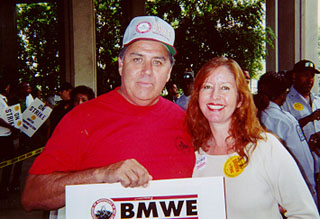
BMWE District Chairman Alberto Jimenez,
Lodge 875, Pacific Federation, with Dr. Gloria Romero, California
State Majority Whip and Assemblymember from the 49th District at a
transit worker solidarity demonstration on September 29 at City Hall
in downtown Los Angeles.
After eight days of the crippling strike, the MTA and union
officials agreed to resume talks under a news blackout. These talks
collapsed on September 26. Further talks started and stopped again as
powerful state officials, included Governor Gray Davis, made proposals
for settlement.
On Friday, October 13, Rev. Jesse Jackson intervened. Jackson set a
Monday, October 16 deadline for resolving the 30-day-old strike and
pressed both sides to negotiate around the clock.
Buses rolled for the first time in 4-1/2 weeks on Wednesday,
October 18 as drivers went to back to work following the ratification
of a new contract late Tuesday which provided raises of 9.3 percent
over three years.
Drivers returned to work with mixed feelings, reported an LA
newspaper. Leonard Jefferson, a bus driver for 19 years, said the new
contract isn't good enough for all drivers. He wasn't surprised,
however, that union members went along. "They didn't vote to
accept the contract," said Jefferson. "They voted to get
back to work and try to catch up on their bills."
Member Profile
September 25 — BMWE Member's Son Competes in 2000
Olympics
"Mom, see those big guys, one day I'm going to dive with
them," 8-year-old Jeff Liberty told his mother as they were
sitting in the stands at the Pan-Am Diving Club in Winnipeg, Manitoba
one day in 1986. Fourteen years later Jeff has made himself an
Olympian.
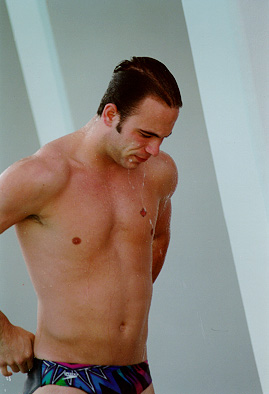
Jeff Liberty
Jeff is the youngest child of Ron and Jo Anne Liberty who have been
married since 1971. His older brother David is 24 and has three
children and his sister Dawn is 28 and has two daughters. Jeff also
has two half-sisters, Claudette and Cindy.
Ron Liberty started working for the Ontario Northland Railway on
January 28, 1969 as a B&B laborer. Because he wanted to see that
laborers were treated fairly and that positions were properly filled,
Ron ran for the office of Lodge 2697 Local Chairman in 1974 and won.
In 1976 he was elected as a Joint Protective Board Member for the
Western System Federation, a position he held until his election to
the System Executive Board in 1980. In 1983 Ron was elected as System
Secretary-Treasurer and General Chairman and in 1995 as System
Federation General Chairman, the position he currently holds.
In Jeff's Olympic profile, he named his father as his most admired
person because "he has always had good advice for me." He
named both his father and brother as his most influential person
because "they have always been there for me."
Jeff was always very adventurous and Ron and Jo Anne knew early on
they had to harness him somewhat. For example, when he was not quite
two, Jeff banged his crib across his bedroom floor to the window and
climbed out to play on the roof. Luckily a neighbor saw him and called
Jo Anne before anything worse than scaring his mother happened. At
three Jeff liked to play Evil Knievel and ride his bike down the
stairs.
The Libertys involved Jeff in sports early in order to use up some
of his abundant energy. That's why they were surprised one day when he
was in the first grade when they were called to school by his teacher
who advised she was concerned about his poor motor skills and short
attention span.
Indirectly Jeff's brother David is responsible for his early
interest in diving. David played hockey and it was the practice for
the team members and their parents to go to the pool often after
practice and at other times. Naturally, Jeff always went along but he
had to stay in the Tiny Tots end of the pool because he couldn't swim
the required two lengths to permit him in the deep end. One day Jeff
noticed a sign that said "join the diving club" and
persuaded his mother to let him join so that he was able to swim in
the deep end.
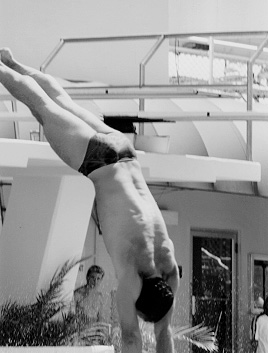
Shortly after joining, diving coach Jim Lambie noticed him and
asked Ron and Jo Anne if they would let him join a pre-competitive
group. After receiving answers to many questions, they agreed. And it
wasn't long before Jeff was transferred to the competitive group.
"Jeff had to work hard and he got a little discouraged at the
beginning after a teammate with natural talent kept beating him,"
says Ron, "but I told him to keep working hard and some day
you'll end up on top." Eventually Jeff did beat him and while he
went on to the Olympics the other boy dropped out of the sport. That
was due in large part to "Jeff's dedication and desire,"
says Jo Anne.
After the family moved to Edmonton in 1990, Jeff joined the
Edmonton Springboard and Platform Diving Club under coach David
Flewelling. About a year later, Jeff transferred to the Kinsmen Diving
Club where he trained under coach Porferio, a Mexican diving champion.
In 1994 Jeff was recruited by Trevor Palmatier of the Vancouver
Acquatic Center and during his two years under Palmatier's coaching,
Jeff established himself nationally. It wasn't easy however, to let
Jeff go to live with Ron's sister Karen and her husband Todd Wilson.
"I cried almost all the way home from Vancouver," says Jo
Anne. "He was only 15 and he was our baby!"
When Palmatier moved to Victoria, the Libertys decided to send Jeff
to Calgary instead so he could stay with Jo Anne's brother Peter and
his wife Joanne Ryan and train under world champion and Olympian Hui
Tong, originally from China. Later Jeff went to live with Jo Anne's
sister Marion Dufresne and her youngest son T.J. 19, still in Calgary.
"I don't know if we could have done it without the great
extended family support," say the Libertys, who entirely funded
Jeff's training through the years. Jo Anne's salary as a receptionist
entirely went into funding and Jeff worked part-time for spending
money. He is currently working as a cook and "just loves it"
says his mother. "But when you train six hours a day, six days a
week, it's hard to hold a job." Ron adds, "Canada's athletes
are vastly underfunded compared to other countries of similar size and
stature. Canada spends about $63 to $68 million compared to
Australia's $275 million."
In Canada, officials take percentages yearly from two international
meets, and the top 12, male or female, holding the highest percentages
are "carded," which means they are on the national team and
entitled to a government subsidy which runs for 12 months, from
October through September. Others than the top 12 on the national team
are not funded.
Under Tong's coaching, Jeff has obtained international status as
one of Canada's top male divers. He very narrowly missed qualifying as
an 18-year-old for the 1996 Olympics in Atlanta and at the Pan
American Games in 1999 in Winnipeg, he placed fourth in the Men's 3m
Springboard. Also in 1999, he was first in the Summer Senior Nationals
in Edmonton in the Men's 10m Platform and the Men's 1m Springboard.
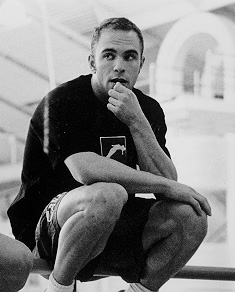
It is a very complicated process to be able to compete in the
Olympics. The first requirement, however, is that someone from Canada
must obtain Olympic standards in meets which qualify to have Olympic
qualifying trials to be held. In 1996 no one met those standards from
Canada.
Jeff and several others did meet those standards this time and
Olympic trials were held in Montreal on June 11, 2000. Jeff started in
first place and stayed there through his 17 dives in his event, the 3m
Springboard, claiming one of the two spots allotted to each country
for this event.
And then a short three months (or long 14 years depending on how
you look at it) later it was off to "the big one" in Sydney,
Australia — the 2000 Olympics — where on September 25 Jeff placed
19th out of 50 divers, just missing the cut to 18 divers.
"We were extremely pleased with his performance," said Jo
Anne. "These were the best of the best and 10 divers out of 50
were all within three points. When you're sitting at the Olympics and
your son walks out in a Canadian uniform, well, I can't describe it,
but both Ron and I had tears in our eyes. It was all worth it. And I
can't help it, I kind of want to pick up the phone and call his old
school and say, "there, how about that for motor skills and
focus!"
Member Profile
Dead Man's Crossing
Laura Baenen, Communications Representative for the Canadian
Pacific Railway, interviewed and took the photo of Eddie Oeftger and
his nephew Don Labrenz on September 25. Both are members of Local
Lodge 2643, CMSTP&P System Federation. Oeftger retired in 1974 and
is an honored Life Member of the BMWE with 61 years of membership and
Labrenz is a 34-year member. Calgary-based Canadian Pacific acquired
the Soo Line Railroad, located in Minneapolis, in 1990. Soo Line
bought the Milwaukee Road in 1985.
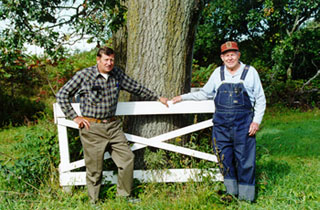
Hard of hearing, retired section crewman Edward Oeftger strains to
hear a visitor's questions about Dead Man's Crossing on Canadian
Pacific Railway's track between Portage and Wisconsin Dells. The old
section hand, though, remembers the sound of the lonesome whistle made
by about 22 freight trains and two Amtrak passenger trains a day as
they pass an unknown man's grave.
"Two longs, a short and a long," said the 87-year-old
Oeftger, with a faraway look in his pale blue eyes as he retells the
story told to him by his father, a Milwaukee Road section foreman for
49 years. "I was probably about 10 years old or so when I heard
Pa talk about it," said Oeftger, who helped maintain the grave
site near his central Wisconsin home during his 40 years with the
railroad.
He doesn't know how long the grave has been there but thinks it
could be as old as 100 years. Oeftger said his father, Gust Oeftger,
was off the day that two farm girls bringing cows in from a pasture
found a man's body on a hill up from the crossing. A section crew
buried the man at the crossing and planted two oak trees on the grave.
A white wooden fence was erected around the grave and the twin oaks,
which still stand. Over the years, track workers painted and rebuilt
the fence, mowed the grass around it and picked up broken tree limbs.
"I remember when the roadmaster was there one time, and he
(Gust) said, ‘Goldang it. I'm getting tired of buying paint to paint
the fence.' And the roadmaster said, ‘I'll send you some.'"
Many of the old track workers who tended the grave are gone. Donna
Labrenz of Wisconsin Dells, whose husband is retired track worker
Herman Labrenz, organized the local Kiwanis Club to paint the fence
last year. Herman's son, Don Labrenz, is a section foreman for
Canadian Pacific Railway; Oeftger is his uncle.
Oeftger said workers believe the dead man was from the Rio area
east of Portage and walked west along the tracks to the spot where he
died. "They found evidence there that he had taken poison,"
he said, adding that no one knew what led the man to take his life.
People gossiped that the man's family wouldn't claim his body due
to some shame he had brought upon them, Oeftger said. Others claimed
that railroad workers hadn't buried a man at all in the grave, but
instead had buried a horse standing up.
"There wasn't a damn bit of truth in it," said Oeftger,
after uttering a barnyard epithet.
A history of the Milwaukee Road by August Derleth contains an
introduction by writer Stephen Grendon, who calls the place Dead Man's
Cut and said it's the grave of a track worker killed during the
building of the road in 1858. Another version claims someone was
killed at the crossing. But Oeftger maintains that's not true either.
Oeftger thinks the suicide victim was buried at the crossing
instead of a cemetery out of necessity because he had been dead for
some time before he was found. Superstition and outdated religious
customs, though, could also explain the trackside burial.
"In western folklore...crossroads are an otherworldly place.
If you want to call up the devil at midnight, you do it at a
crossroad," said librarian Moira Smith, who is in charge of the
folklore collection at Indiana University. "When it comes to
suicides, you couldn't bury a suicide traditionally in hallowed ground
because they had died in sin."
Whichever, engineers still blow two longs, a short and a long
whistle as they pass the lonesome spot near where a county road
crosses the track just east of milepost 184 in the Tomah subdivision.
To this day, though, "it's colloquially known as Dead Man's
Crossing," said Steve Moerke, the Portage road manager.
Writer Stephen Grendon, in his introduction to August Derleth's
history of the Milwaukee Road, said Dead Man's Cut on the railroad's
line near Portage, Wis., was the subject of Alfred Burrett's poem,
"The Grave of a Section Hand:"
They laid him away on the brow of the hill,
Outside of the right-of-way,
And the old boss whispered: "Peace, be still
Till the call on the Final Day."
They had placed him where he had wished to lie
When his turn would come, he said:
Where he'd list to the wires' mournful sigh,
To the foreman's "Joint ahead!"
For many a year he had paced the beat;
He had pumped o'er every tie;
And now from his narrow, last retreat,
He could feel the freights roll by;
For from his rest, ‘neath the willow's shade,
His spirit would guard the track;
He would know when the engine struck the grade,
Hear the call,"Center back!"
September 29 & 30 — Secretary-Treasurer Seminar,
Spokane, Washington
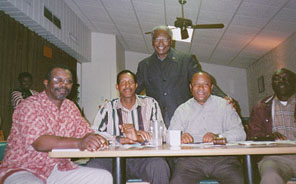
"This is a photograph that was taken at a joint meeting of
Allied Eastern Federation Local Lodge 562 and Seaboard Federation
Local 593 on September 30," writes Haywood Proctor Jr., South
Carolina State Legislative Director. "This was a special
Political Meeting held to encourage our members to get-out-the-vote on
November 7. Our special guest was Congressman Jim Clyburn, a Democrat
from the Sixth District and a friend to the BMWE throughout his
service in Washington. His expression of appreciation for the local
BMWE's involvement in his campaign and his presence at the meeting was
a great encouragement to the over 50 BMWE members and their families
in attendance." Congressman Clyburn is standing with from left to
right, Lodge 562 members Harry Campbell, Secretary- Treasurer, Larry
Alexander, Vice President, B. D. Moses, President, and James Tart,
President Emeritus.
|

